Sarah Mykkanen is a smart, passionate, outgoing, level headed, pretty lady—who happens to love coffee. Lucky for us, she also happens to be one of our barista’s here at Heart.
Sarah planned a solo trip to Central America for the next month and a half, where she could soak in the culture and learn about the farming practices that make it possible for her to make delicious coffee here at home. Before Sarah left for her journey, I met with her to discuss what she would be doing and how we would be kept in the loop–a bit of an itinerary run down.
The plan was simple. She would be contacting specific farms that she has enjoyed coffee from. Any knowledge she could gain along the way and take back with her—would only make her a more well-rounded barista.She will be volunteering her time wherever she can on the farms and is planning to keep an open schedule for any opportunities that may arise (she will most likely be meeting up with Wille, while he is sourcing coffee at the end of February!).
We will be sharing some of Sarah’s experiences and pictures through our blog as we receive them via email. I thought I would be editing these written experiences, but I think its’ entirety is worth reading. Thanks Sarah, for keeping us informed!
-Rebekah Yli-Luoma
January 13,2012
Sitting here, looking out over the ocean, with a wamr breeze and mangrove trees.
I can finally relax and write about the past few days and my first coffee farm visit! I am in Playa El Tunco, El Salvador, a cute little surfer town….I feel like I have been travelling for a month already.
So, Ricardo Zelaya owns Finca Santa Clara, just outside of Antigua, Guatemala. He was supposed to pick me up at 10:30 and take me out to his farm. At noon, I got a call that he was 10 minutes away. At 12:30, I saw a silver BMW roll slowly by the hostel—I knew it was him. I waved him down and hopped in his car (something I have never done in Guatemala).
A welcoming yet assertive businessman, as we wound through the cobblestone streets of Antigua, Ricardo began asking me about Heart. Asking if I was a roaster or a buyer, if we have wholesale accounts and how much coffee we buy per month. I answered his questions as best I could, explained my connection to the guy who introduced me to Ricardo. I explained that I was just a barista, but I am the one in charge of the final step in the whole coffee chain. I am the one talking to the customer and selling the coffee—and that I wanted to learn more about what he does and bring it back to the customer.
He seemed to respect my answer and the conversation lightened. I appreciate his straight forward, no BS attitude though.
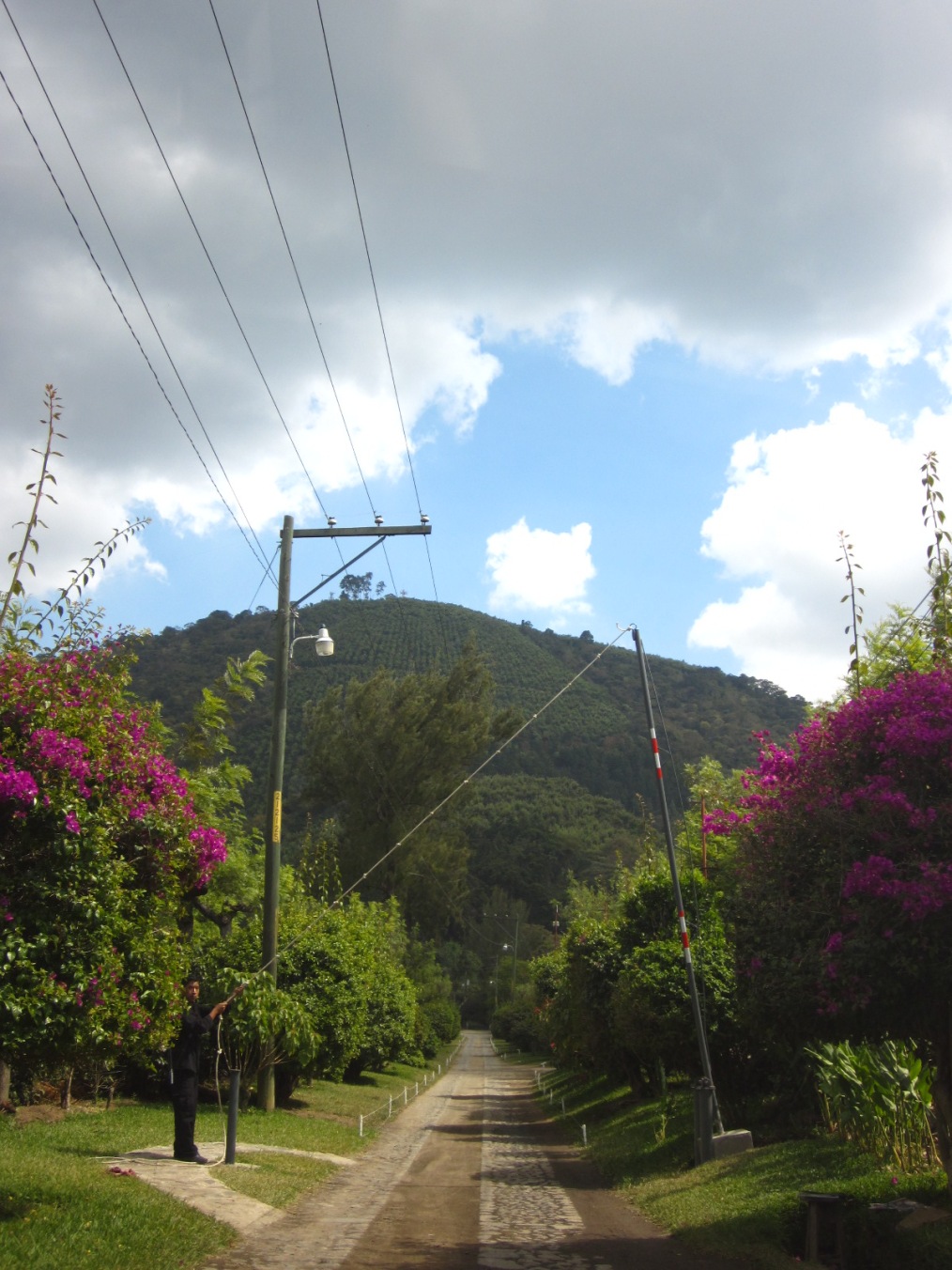 This is the view driving into Santa Clara. You can see the coffee fields up the mountain
This is the view driving into Santa Clara. You can see the coffee fields up the mountain
We turned the corner and pulled into Santa Clara–coffee lots on either side of the drive, straight ahead was a mountain with coffee plants all the way to the top. I was grinning. It was beautiful and I was so excited! A quick stop in to the fanciest house I have ever seen in Guatemala and then Ricardo and I were off in his camo 4WD golf cart (so fun!). He started by showing me the lowest part of his plantation—bourbon and bourboncito varietals. He explained that he prunes every few years and re-plants when necessary. He informed me that the trees he uses for shade come from Ireland (or somewhere in Europe) and can withstand temperatures down to 20 degrees below zero. He showed me plants that were more than 30 years old. He pointed to sprinklers up on the mountain and told me about his irrigation system and that is hasn’t rained since October 16th!
I know I said this before, but it was so beautiful. The plants, all evenly spaced, royal looking shade trees overhead, warm and humid, the smell of damp earth and sweet fermenting fruit—probably from the wet mill.
As we climbed in elevation, I started to see more ripe cherries. We started to see Florafundia, a tall plant with bugle shaped white flowers that hang down—the most intoxicating tropical smell.
We passed a woman who was moving around irrigation hoses and I asked about the worker situation. Ricardo has 40-50 workers through out the year and sometimes up to 250 during harvest, both men and women.
When we got to the top, the view was amazing! At 1700 meters, Volcan Agua was directly to our left, towering another 2000 meters. The colonial town was spread out on the valley floor, shimmering white and orange. Ricardo pointed out his aunts farm, his brothers farm, and 3 other farms he is managing: Jauja, Santa Ines, and Puerta Verde.
“What!? Puerta Verde?!” I asked. I told him that was the coffee I made the day I left Portland and how it was a favorite at our shop. I told him that we bought a lot of it and that Wille roasts lighter than others to bring out the natural flavors of the coffee, rather than tasting the roast. “Okay,” Ricardo said, “After lunch, Vamos a Puerta verde!”
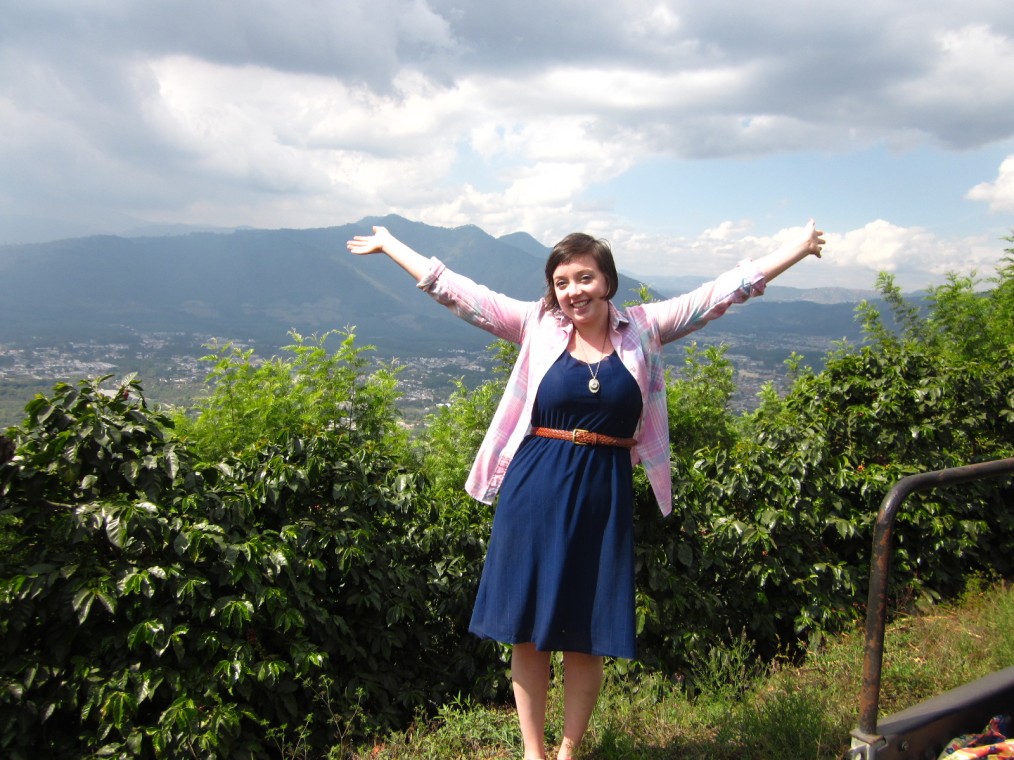
Me, very happy, overlooking Antigua Valley.
During this whole, very animated exchange, Marcos, the foreman who was with us, got a call that the pickers had finished at Jauja and were starting to sort. Ricardo drove us to Jauja, in his 4WD golf cart, zipping around corners and busses on the side of the road. Sun shining, wind in my hair, I was holding on for dear life. I was stoked.
We pulled into Jauja, and I immediately could see the wealth disparity between the coffee grower and the workers. There were more women (mostly indigenous) than men and cute kids running around playing. Some workers were alone and some in groups–with their coffee spread out on tarps, sorting out the dried out or unripe cherries.
I took some picture of the kids, asked their names and some other questions. I know that some Mayans believe that a photograph captures part of your soul and some people I asked didn’t want to be photographed. I started talking to this older woman who was working alone. She hardly spoke Spanish, needing someone close by to translate into Quiche, extremely timid and soft spoken, she hardly whispered that her name is Marielena and that she came all the way from the Quiche region (about 5-6 hours away) to work the coffee harvest.
She let me take her photograph and I said “montiosh,” which means “thank you” in Katchiquel, an indigenous language closely related to Quiche. I wanted to talk more to the workers about their lives, etc, but everyone was pretty wary of my presence. I understand though. They were working and I zoomed in with their boss who was watching them, with a camera in their face. Hopefully soon, I will be able to get in the fields and build that trust by showing kindness and working hard.
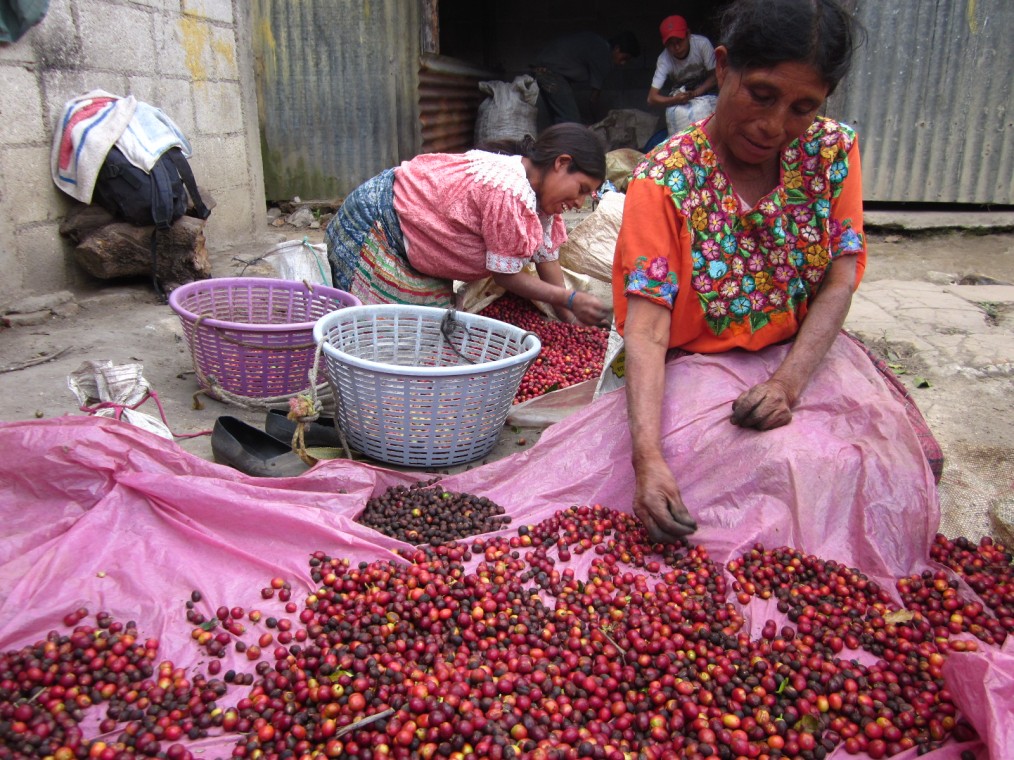 Dona Marielana sorting. She traveled here to work the harvest and speaks mostly Quiche.
Dona Marielana sorting. She traveled here to work the harvest and speaks mostly Quiche.
The workers lined up their bags to be weighed and were dumped into the back of a truck to check the quality of each workers picking and sorting. It was such an honor and special to witness. Most striking though, was the realness of these people–the “farmers” who we talk about daily in the coffee shop and somewhat objectify. There I was, faced with their poverty, their smiles, their language, and their children. Getting to know them might be a little harder than I thought, but I am still going to try.
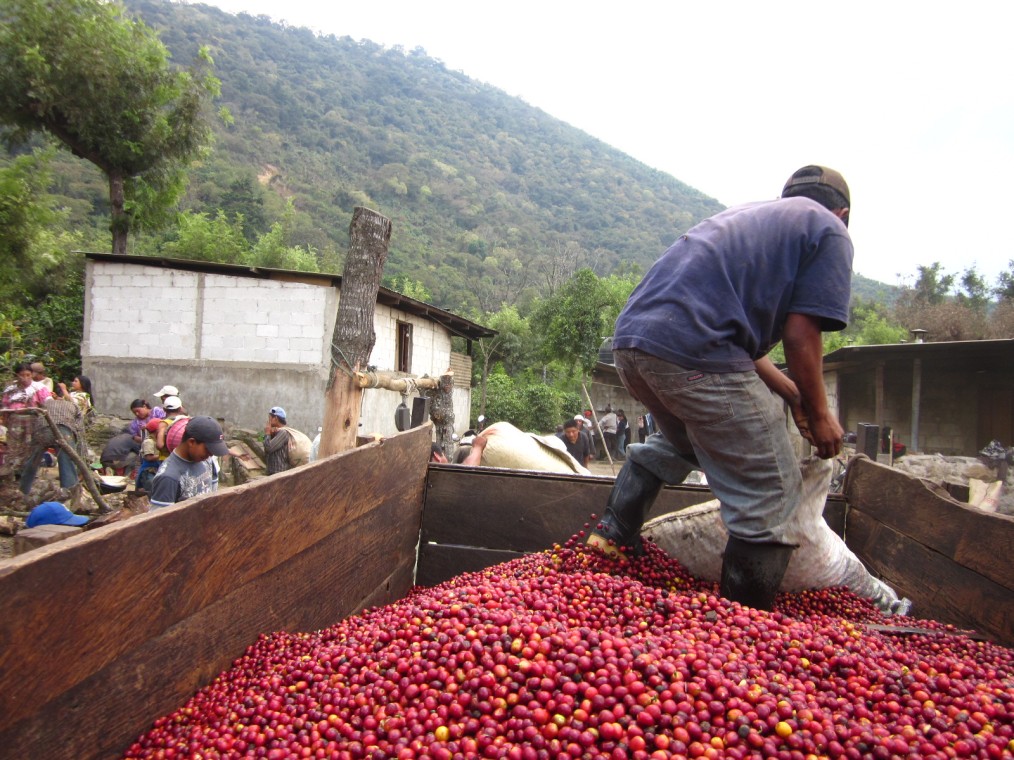
Dumping Harvest into the truck and checking quality.
Ricardo and I zipped back to his hacienda and had lunch of chicken, rice, vegetables, and soup that his maid, Gloria had prepared for us. We ate on his back deck, overlooking his lawn and pool. He told me that owning a coffee farm was like owning a black hole for money. You make an initial investment, but you never really make it back, because something is always in need of repair. I said it was sort of like coffee shops and we both agreed that everyone in this industry must be a little crazy to love coffee so much.
After lunch, we went to the wet mill. They had dumped the coffee from the truck, but hadn’t started the machines. Ricardo had them fire it up and was explaining how it all works to me.
He showed me the de-pulper, and how the good coffee falls through the holes and goes into a tank where it ferments for 12-30 hours. There was some coffee from previous days harvest fermenting in a tank. I reached in with my hand to scoop some out to smell and for a closer look, just like I scoop green coffee out of the bins at Heart. The coffee was soft and so slimy!
Then, Ricardo showed me where the “bad’ coffee goes—the coffee that floats or isn’t ready and doesn’t de-pulp. It flows into a tank, with a sort of dam, so the “bad” coffee flows over the edge, while the “good” coffee stays in the tank.
We walked toward the drying patio and there was a pipe dumping a pile of coffee cherries on the ground.
“And this is where the bad coffee ends up…” Ricardo explained, “what you would call…a…how do you say….natural.”
Ha! No wonder. I had no idea that some naturals can be coffee that was picked too soon and considered “bad.”
He showed me the patios. He told me the guy that is in charge knows the coffee so well; he can tell when it is finished drying. The patios sit right at the foot of the hill we had just climbed.
There was a room with some guys removing parchment from dried coffee, checking for defects, and sifting samples through screens. I thought it was pretty cool to see the actual screens and process.
Earlier, Ricardo had asked me if I had heard of an “Airpress.” Aeropress? “Yes!” He said,
“Airpress!”
He had been given one and wanted me to teach him how to use it. So, we unwrapped his brand new aeropress, used some coffee he had roasted–and in broken Spanish & English, I gave Ricardo and his maid Gloria the Aeropress tutorial. We each drank our coffee. Ricardo, out of his “worlds greatest dad” mug on the back porch and Ricardo showed me/told me about some of the awards Santa Clara and Puerta Verde had won. Ricardo is really proud, as well he should be, of his families coffee success and roots in the Antigua area. It’s a family business. Even Marcos, the foreman, took over his fathers’ job when he got too old. Marcos dad still lives on the farm in la casa del guardian.
We hopped back in the golf cart and headed over to Puerta Verde! I was all smiles and so excited! To see the farm, the plants, the origin of a coffee I had just been working with and getting to know was literally a dream come true.
To be a barista is to dance with coffee, letting it lead and learning to follow–getting to know all of the flavors and what to do to bring out the sweetness, the right amount of bitters.
Barista’s who care, get to know the coffee they work with intimately and create a delicious cup for the customer. Yet, we are so separated from where it comes from. We talk about the farm; try to learn about all the facts: elevation, varietal, screen size, process, farmer’s name, correct pronunciation, but nothing compares to going there. What I am trying to say to you all is that this was huge for me—-in the best, coffee-nerdiest way!
We turn in, just off the highway. Marcos opens the gate and there are about 15-20 chuchos (stray dog&puppies) running around—the casa del guardian to my right. Flat and serene, sun peeking through the shade trees, we start down the rows.
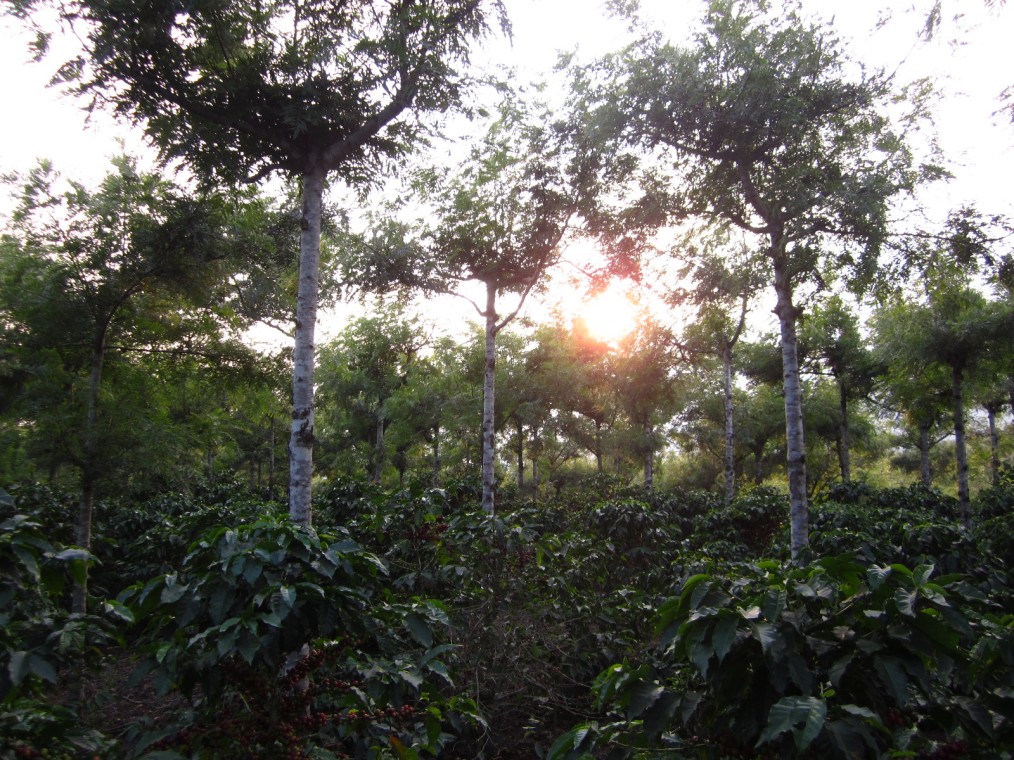
Finca Puerta Verde, Bourbon Plants, lush and beautiful.
Ricardo tells me that this was once a pig farm long ago and later divided up into coffee farms.
The owners called him in to consult. He helped them re-plant and dealt with a theft problem, and now he manages the farm.
We passed lots of bouborn, bourboncito, and caturra. Most of the fruit was ripe—Ricardo said they would pick in a few days. Caturra is beautiful, with lots of cherries, like rubies, close together. Bourbon is a larger plant, more spaced out. Ricardo compared it to a high performance car. It can be amazing, but needs a lot of room to grow, requires a lot of attention, and isn’t always the best producer. The bourboncitos is a newer varieta. It is a smaller, heartier, more condensed version of the bourbon. He called it a bulldozer.
He showed me wells he had made and how the water table was just 15 feet below the last crop, what we were serving. There had been a storm and the water table came almost to the surface—the plants kept growing (instead of putting that energy into producing coffee).
I saw 5 month old plants, 10 year old plants, and freshly pruned plants. I saw flowering plants and smelled my first coffee blossom. It’s an aroma we talk about a lot and it was awesome to finally smell one in real life! I would say sweet smelling, like plumeria, but with some of that light pungency of jasmine. He showed me a trick he uses to taste the coffee. You pick a ripe cherry, squeeze it until the beans pop into your mouth, suck off the mucilage, and spit out the beans. This is how you taste the “honey,” the sweetness of the cherry.
As we finished the tour, the sun was starting to go down, Volcan Agua stood guard over Puerta Verde.
Ricardo pulled out of the farm into rush hour traffic on the highway into Antigua. I held on for dear life again as he cut off a chicken bus and sped me back to my hostel. A barista’s dream come true.
And now I am in El Salvador, relaxing before I visit 2 more farms next week……..













